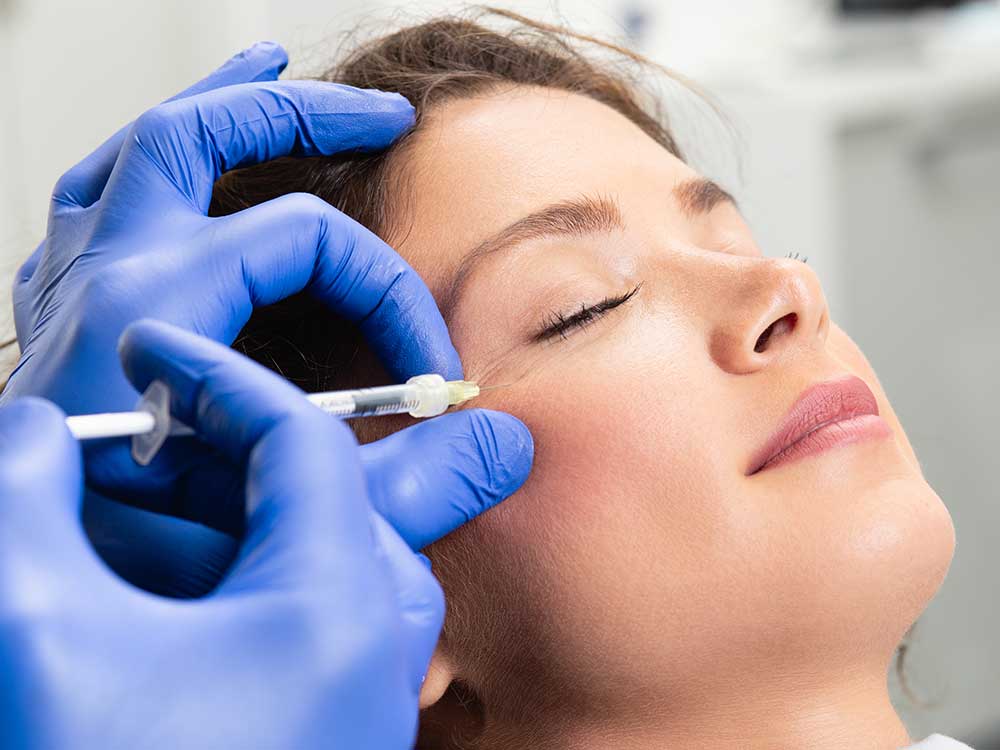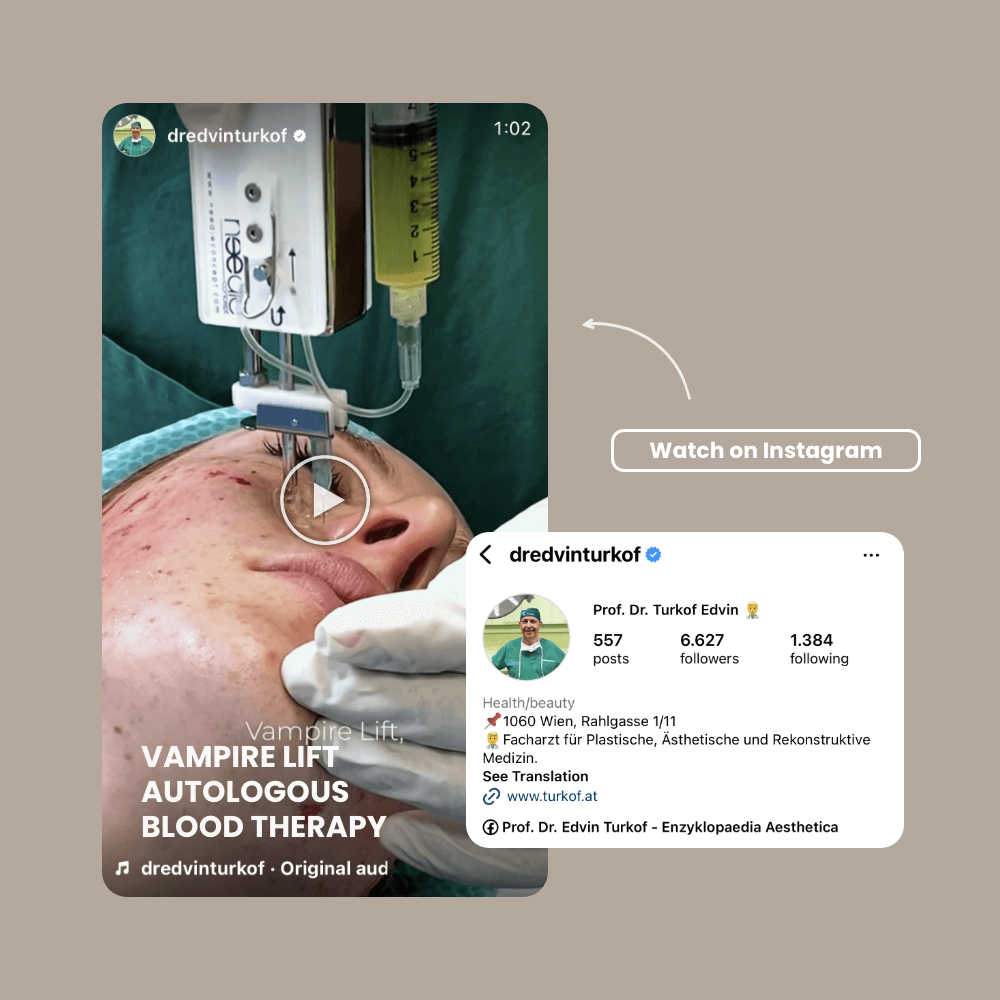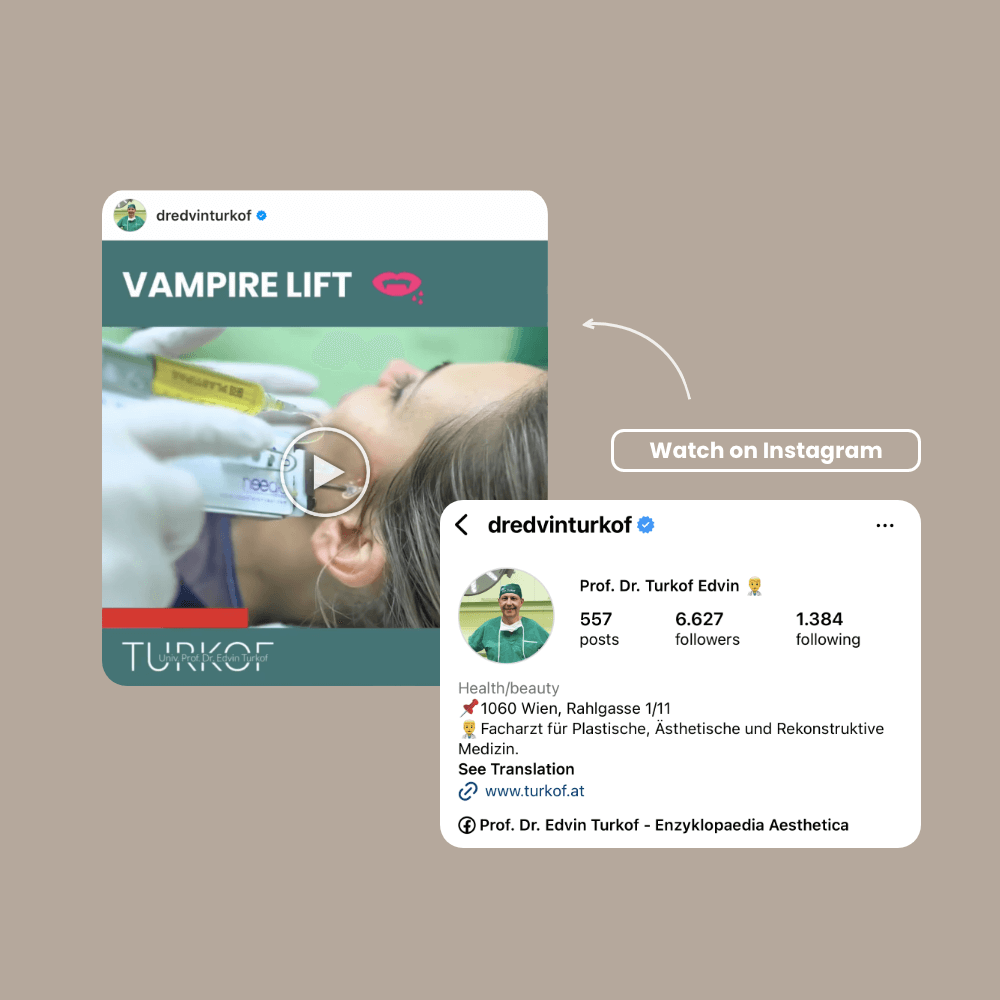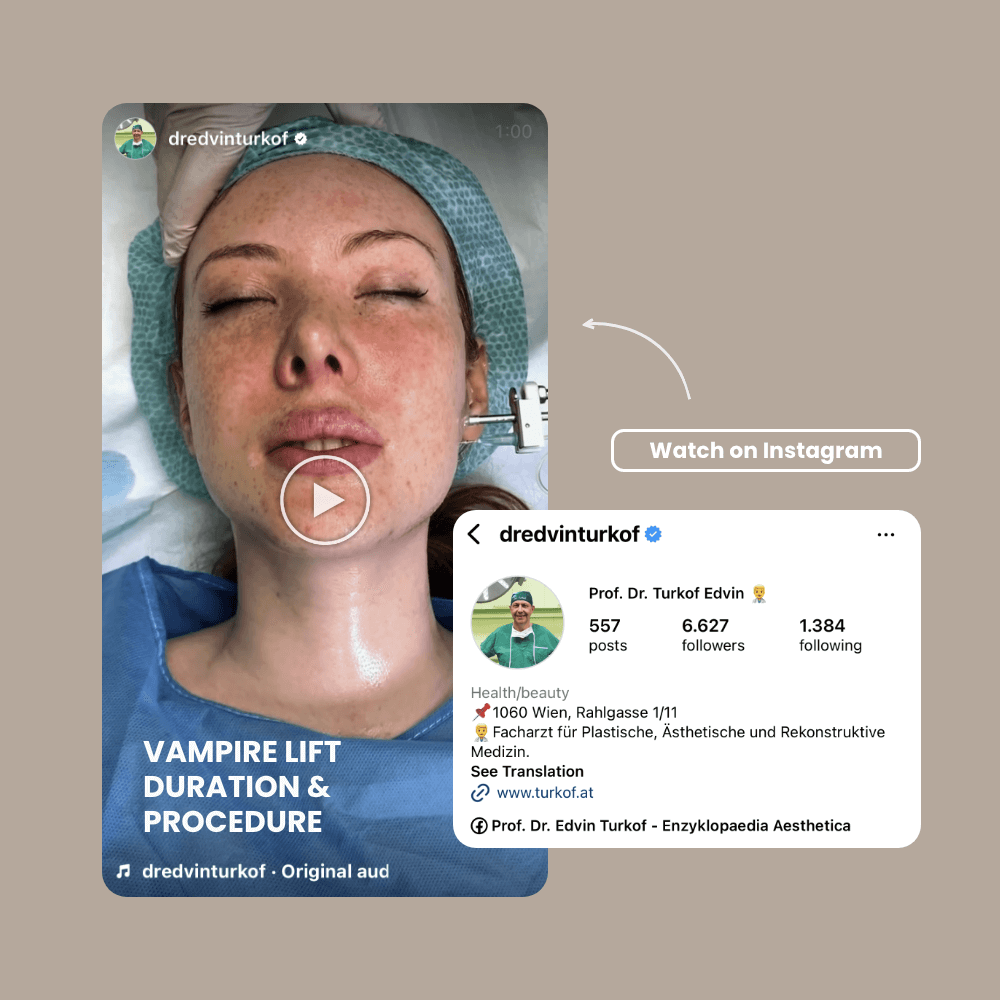What is a Vampire Lift and what are its benefits?
Celebrities such as Kim Kardashian, Bar Refaeli, and Gisele Bündchen swear by this “bloody method,” which revitalizes tired skin, restores volume, and smooths out fine lines. The PRP autologous blood therapy, also known as the Vampire Lift, provides an all-around rejuvenation of the skin and face.
The Vampire Lift is an innovative and highly effective anti-aging treatment that requires no surgery, laser, or peeling, making it a particularly gentle way to renew the skin. The PRP obtained from your own blood is injected beneath the skin using a specially designed device.
Advantages
- The skin appears fresher, firmer, and more resilient — fine lines are reduced or disappear.
- Visible improvement in skin texture and quality is usually noticeable after the very first treatment. Often, a single session is enough to achieve the desired effect.
- Excellent tolerability thanks to the use of the patient’s own blood.
- Almost painless due to the use of a special “Derma-Injector.”
The Vampire Lift is now known under various names: Vampire Lift, autologous blood therapy, plasma lifting, or Dracula lifting — all referring to PRP therapy (Platelet-Rich Plasma).
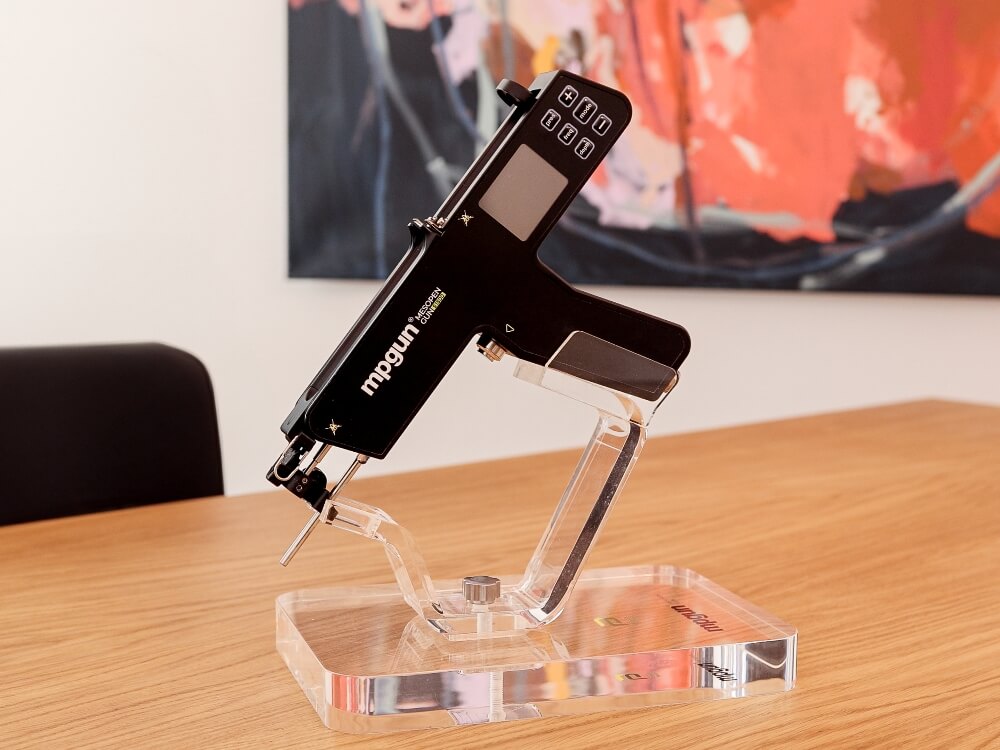
What can be corrected with PRP autologous blood therapy?
The Vampire Lift is suitable for anyone struggling with impure, slightly wrinkled, sagging, or low-volume skin. It can also be used for skin rejuvenation on almost all areas of the body.
By the late twenties, the rate of cell division begins to slow down, causing the skin to gradually lose its ability to renew itself and retain moisture. The skin becomes dull, loses elasticity, and the first fine lines appear. Stress and daily pressure further strain the skin.
Many people increasingly feel the effects of today’s fast-paced lifestyle.
The Vampire Lift is an excellent method to counteract these signs and restore a radiant, rejuvenated complexion.
PRP can slow down skin aging
The age-related slowdown of skin cell renewal can be reactivated through PRP autologous blood therapy. The body’s own healing powers are stimulated, and the resulting increase in collagen and elastin production leads to a fresher complexion, refined pores, and the reduction or disappearance of fine lines and wrinkles.
Many patients choose this conservative method to achieve a rejuvenated, natural appearance instead of undergoing a facelift.
For optimal and long-lasting results, I recommend three treatments spaced three weeks apart and, depending on skin condition, maintenance sessions every 4–6 months.
PRP promotes cell growth and regeneration
PRP consists of concentrated platelets (thrombocytes). Like red and white blood cells, platelets are essential components of blood and are primarily responsible for blood clotting. When an injury occurs, platelets close the blood vessels by forming a clot, preventing further blood loss.
Once bleeding stops, the platelets initiate the healing process by repairing the damaged vessels and surrounding tissue. They release growth factors that enhance cellular regulation and stimulate cell regeneration.
Areas of application for PRP autologous blood therapy
The vampire lift is suitable for women and men who desire firm, clear, and radiant skin. The therapy can be used for skin rejuvenation on almost all areas of the body, though it is most commonly applied to the face, neck, décolleté, and hands. It has also shown good results in treating stretch marks, cellulite, and pregnancy-related skin changes.
Who is not a good candidate for PRP treatment?
If you are looking to correct deep wrinkles or significant volume loss, a fat graft (autologous fat transfer) or augmentation with hyaluronic acid is the better choice. For dynamic or deep expression lines, I recommend treatment with Botox.
Facts about the Vampire Lift at a Glance
| Treatment duration | approx. 45 minutes |
| Hospital stay | outpatient |
| Aftercare | cooling |
| Pain level (1–10) | 1–2 |
| Downtime | none |
| Sports | from the 1st day after treatment |
| Socially presentable | 1–3 days |
| Costs | from 500 euros |
Microneedling and Mesotherapy
Another well-established method in aesthetic dermatology is microneedling. By creating numerous small needle punctures, 1–2 millimeters deep across the facial area, the skin’s natural regeneration process is activated. This stimulates collagen production within the skin cells. After just a few weeks, the skin appears firmer. Microneedling is not directly related to the vampire lift but is often performed in addition to it — that’s why it is mentioned here.
Another proven method in aesthetic dermatology is mesotherapy. Using a very fine hollow needle, active ingredients (vitamins, enzymes, hyaluronic acid, etc.) are injected into the superficial skin layer — either manually or with an injector. This method improves the skin’s appearance even more effectively than microneedling.
In other words, mesotherapy is essentially microneedling plus the injection of beneficial substances. Although mesotherapy is not primarily part of the vampire lift, Prof. Turkof combines it with the vampire lift — unlike many other institutes — instead of using microneedling.
What makes Prof. Turkof’s PRP autologous blood therapy so effective
In many other institutes, after the vampire lift, the skin surface is lightly punctured with a dermaroller (= microneedling) and then PPP (= platelet poor plasma) is massaged into the skin by hand. PPP is the less effective plasma (it contains only a few platelets) that remains after PRP has been extracted.
However, because the skin bleeds through the small punctures created during microneedling and these micro-wounds close almost immediately once clotting begins, the applied PPP can hardly penetrate the skin — if at all. And even if it did, its effect would be minimal, since PPP contains far fewer platelets than PRP.
Prof. Turkof replaces the microneedling and ineffective PPP massaging with genuine mesotherapy using PRP.
The standard microneedling method with the dermaroller in detail
The dermaroller is a sterile single-use device resembling a small roller covered with many fine needles. The roller is pressed firmly over the skin, creating hundreds of tiny puncture wounds.
This procedure is very painful and is therefore performed either under twilight sedation or after pre-treating the skin with a local anesthetic cream (Emla). Afterwards, the PPP (Platelet Poor Plasma) is applied to the area of skin previously treated with the dermaroller.
In theory, this method is intended to allow the PPP to penetrate the skin.
This method is ineffective because:
- The tiny puncture channels in the skin close very quickly, preventing most of the PPP from penetrating.
- PPP contains significantly fewer platelets than PRP, so even if a small amount of PPP enters the skin, its effectiveness is very limited.
Many institutes combine the vampire lift with microneedling (dermaroller) and the application of PPP — we do it differently.
The special method of Prof. Turkof in detail
Preparation: The number of platelets is not the same for everyone. Since the platelet count has a significant impact on the outcome of the vampire lift, we always count the platelets beforehand.
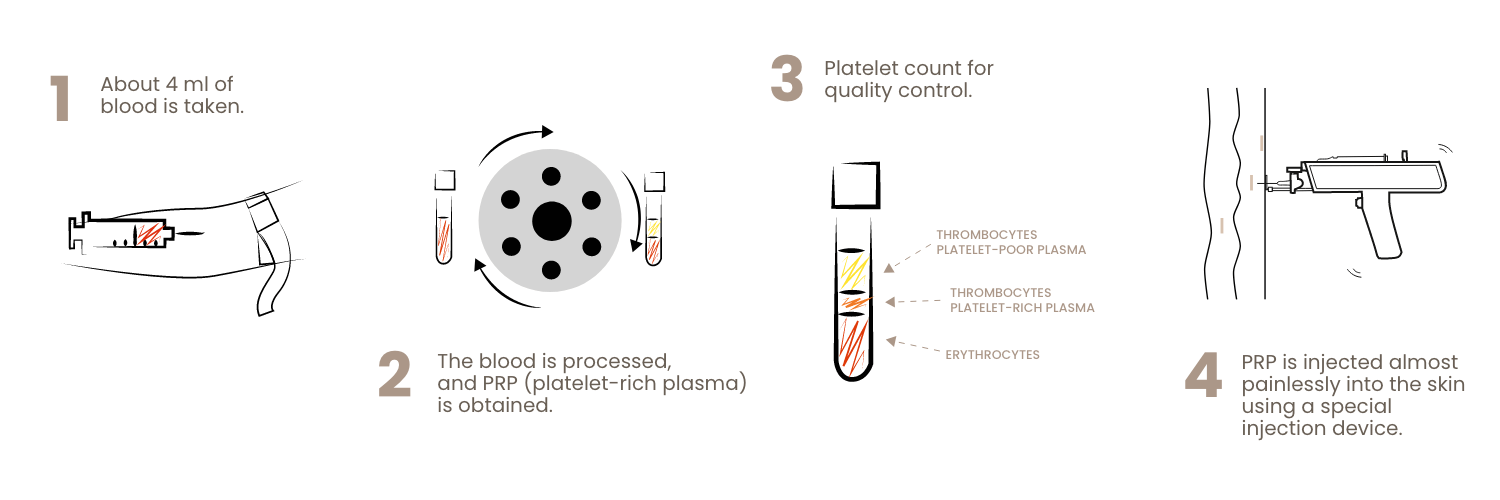
In the lower half of the tube, the compressed red blood cells are visible, and above them lies the plasma. In the lower third of the plasma column, the platelets are concentrated (PRP = platelet-rich plasma), while in the upper part, they are only sparsely present (PPP = platelet-poor plasma).
For the vampire lift, the lower third of the plasma column is drawn up with a syringe and then injected beneath the skin.
Platelets cannot be seen with the naked eye, so their quantity cannot be determined without measurement. Since the number of platelets per milliliter of blood varies from person to person, the effect of a conventional vampire lift treatment can also vary significantly.
That is why it is extremely important to determine the platelet count after centrifugation.
Typically, this is not checked, as a cell counter is expensive and not part of the standard equipment in most aesthetic medical practices. However, because we aim to achieve optimal and, above all, reproducible results with every treatment, the use of a cell counter to determine platelet concentration is standard in our clinic. Only in this way can we verify how many platelets are contained in the prepared PRP.
If there are too few platelets in the PRP, the necessary platelet concentration for optimal effectiveness can be achieved through additional centrifugation or a new blood draw. This ensures a consistently high-quality treatment.
The Vampire Lift method by Prof. Turkof offers clear advantages
The “Derma Injector” – the (almost) painless Vampire Lift treatment
With the Derma Injector, both the depth and frequency of the injections can be precisely adjusted to your skin.
We inject the PRP using the Derma Injector first into the deeper layers of the skin, and then—via mesotherapy—directly into the superficial skin layer. Thanks to the Derma Injector, the treatment is (almost) painless.
Usually, no local anesthetic cream (such as EMLA) is required. However, if you are particularly sensitive to pain, it can of course be applied beforehand.
Enhancing PRP therapy with mesotherapy using vitamin/hyaluronic acid solutions
We recommend a mesotherapy treatment about two weeks after the Vampire Lift, using various vitamin and hyaluronic acid formulations. This complementary session enhances the PRP’s effects and extends the duration of the results.
Mesotherapy can also be performed as a standalone treatment.
Hyaluronic acid acts as a water reservoir, improving elasticity and firmness, while vitamin complexes stimulate the metabolism and smooth the skin.
The effect of a standalone mesotherapy treatment, however, lasts about two weeks.
This procedure is similar to the Vampire Lift, with the difference that no blood is drawn, and the vitamin complexes are injected into only one skin layer, requiring just one treatment session.
How does PRP (Vampire Lift) therapy work?
An appointment for the Vampire Lift can already be scheduled during the consultation.
1. What to consider – who should avoid the treatment?
Blood-thinning medications should be discontinued at least 10 days before treatment. Pregnant women, patients with tumors, or those with blood clotting disorders must consult their doctor beforehand (treatment may not be suitable in such cases).
2. Blood collection and preparation
A small amount of blood (approx. 40 ml) is drawn and centrifuged. This process separates the blood cells (red and white) from the plasma. The platelets remain in the plasma and accumulate at the bottom of the tube. The concentrated platelet-rich plasma (PRP) is extracted and analyzed with a cell counter to determine the exact platelet concentration before application.
3. Reintroduction of PRP into the skin
The extracted platelet concentrate (PRP – Platelet Rich Plasma) is then injected back into the skin. Since skin thickness varies individually, the injection depth is adjusted accordingly.
The PRP is administered in two steps:
- Into the deeper skin layer (just below the surface)
- Into the superficial skin layer
The entire treatment lasts about 30 to 45 minutes.
4. Results
Immediately after treatment, the skin appears plumper and slightly swollen. For optimal, long-lasting results, three sessions spaced three weeks apart are recommended, followed by a maintenance session every 4–6 months.
5. Aftercare and skin care
Cool the treated area at home during the first few days and use only high-quality skincare products.
6. After the treatment
You may experience mild redness or small pinpoint bruises that typically disappear within a few days. On the day of treatment, the face may remain slightly flushed.
Avoid intense exercise, UV exposure, sauna, and swimming for 3–4 days.
Refrain from make-up for 24 hours, as the skin is temporarily sensitive.
7. Risks
The risks of the Vampire Lift are extremely low since the injected plasma is derived from your own blood. Allergic reactions or incompatibilities are virtually impossible. Minor redness, swelling, or small bruises may occur temporarily, and infection is rare.
